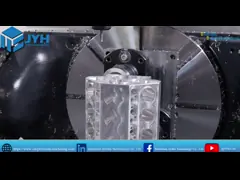Custom Metal Stamping Laser Cutting Part Sheet Metal Fabrication
Service
What is sheet metal processing?
Sheet metal fabrication is a subtractive manufacturing process in
which parts are formed from thin sheet metal. Engineers often
choose sheet metal parts because of their high precision and
durability, especially for end-use applications such as chassis,
housings, and brackets.
Efficient and high-precision sheet metal machining, coupled with
JYH's wide range of materials, a range of sheet metal machining and
post-processing options, means you can get parts for any
application. Sheet metal applications include aerospace, defense,
automotive, energy, industrial, medical, consumer goods.
- ISO 9001: 2016
- Fast delivery service with DHL/FEDEX/UPS
- Standard-DIN-2768-1-fine
- Free quotation with DFM review in 1 hours
- Deburr all sharp edges: 0.1 - 0.2 mm
- Surface roughness: Ra 1.6
What is metal stamping?
| What is laser cutting?
|
From a high level perspective, metal stamping involves creating a
mold that acts as a kind of mold for the part you wish to create.
The die is then pressed into malleable metal with enough force to
make its shape conform to the shape of the die, thus forming the
part. Laser cutting, on the other hand, involves using powerful and
very precise lasers to cut different metals into the desired shape.
| Laser cutting can be set up digitally, allowing production to begin
immediately. The complexity of the part is also often a factor in
whether you choose laser cutting or stamping production. If the
part has a complex geometry, then the laser may be more suitable,
and the laser cutting machine can cut out many complex geometries
with different dimensional characteristics on the same part. It can
also nest parts of many different shapes and sizes on the same
piece of material, which is ideal for clusters of parts used
together in welding or assembly.
|
Our metal stamping industries include, but are not limited to:
automotive, aerospace and medical etc.
- Automotive Metal Stamping - Metal stamping can be used to create
hundreds of different automotive parts, from the chassis, to the
door panels, to the seat belt buckle. See our Automotive Metal
Stamping page for more info.
- Aerospace Metal Stamping - Metal stamping is a critical process in
the aerospace sector, and can be used to create a wide range of
different parts and components for aerospace projects.
- Medical Metal Stamping - Precision metal stamping can be used to
create parts and components with quality and tolerances needed in
the medical space.
Advantages of Sheet Metal Fabrication
The sheet metal fabrication process is ideal for metal components
and can support both prototyping and production quantities.
Sheet metal has some precautions to pay attention to:
Material limitations: Although sheet metal is versatile, depending
on the application and desired material properties, sheet metal may
not be suitable. Some parts or applications may require more
plastic or elastic materials.
Thickness limits: Depending on the method, the thickness of the
sheet metal may be limited while maintaining structural integrity.
There are also only so many standard thicknesses available -
customers may have to adjust the design to standard gauges when
designing sheet metal fabrication components.
Finishing requirements: Some sheet metal products may require
additional post-treatment or finishing to improve their aesthetics
or resist external factors.
Geometric limitations: Metals can only be folded a certain number
of times or stretched to a certain depth, or cut to a certain
thickness, before deformation, cracking, or other damage occurs.
Depending on the shape, additional processes such as die casting,
forging or injection may be required.
Sheet Metal Fabrication Standards
| Dimension Detail | Metric Units | Imperial Units
|
Edge to edge, single surface |
+/- 0.127 mm |
+/- 0.005 in. |
Edge to hole, single surface |
+/- 0.127 mm |
+/- 0.005 in. |
Hole to hole, single surface |
+/- 0.127 mm |
+/- 0.005 in.
|
Bend to edge / hole, single surface |
+/- 0.254 mm |
+/- 0.010 in. |
Edge to feature, multiple surface |
+/- 0.762 mm |
+/- 0.030 in. |
Why use JYH’s for sheet metal fabrication?
Fast quoting & DFM feedback
| Quality & reliability |
Build and edit your quote within 30 minutes. Review your parts for
manufacturability and assess the cost of different materials,
processes and lead times for your project in real time.
| Dedicated JYH’s team to ensure your parts consistently meet your
quality expectations. We also offer phone, email and chat support
for any concerns or questions you may have. |
Our workshop
JYH Precision Shipping way
JYH Precision Payment method
FAQ
1. What are the tolerances for fabricated parts?
Sheet metal fabrication tolerances refer to the acceptable
deviations for features of sheet metal parts required for accurate
and consistent installation and integration.For sheet metal parts,
ISO 2768-mk is usually used to ensure proper control of the
elements of geometry and size.
The following will show you 7 tolerance standards range of linear
and angular dimensions, flatness & straightness, cylindricity, and
circularity.
2. How much does sheet metal fabrication cost?
Every aspect of a sheet metal fabrication project comes with an
associated cost — the design, possible prototype, finishing
processes, and others. Asides from the process itself, materials
also cost money.
3.Whatis the lead time for our project?
It need to based on your product's size and QTY/Structure.
JYH is your best partner of Sheet Metal Enclosure Fabrication And
Production Stainless Steel Sheet Parts!



